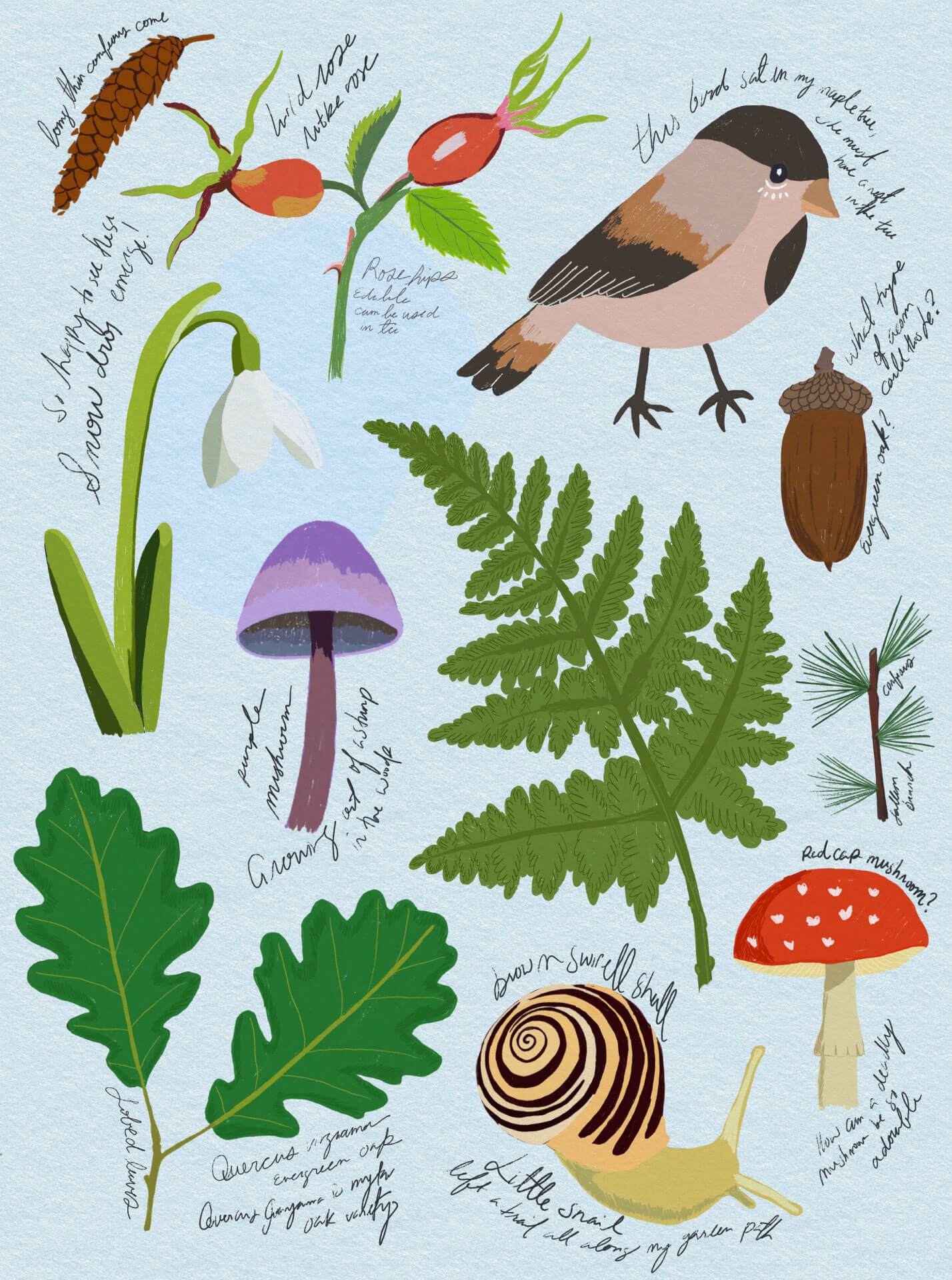Nature Journaling for an Enriched Life.
Written by Alanna Burns, Illustration by Jaclyn Simon
“A child’s world is fresh and new and beautiful, full of wonder and excitement. It is our misfortune that for most of us that clear-eyed vision, that true instinct for what is beautiful and awe-inspiring, is dimmed and even lost before we reach adulthood.” – Rachel Carson, The Sense of Wonder.
As people we are naturally observant. Without realising it, you take in an incredible amount of information throughout the day. You unknowingly take in your surroundings while you’re driving or walking, to watch out for danger or objects of interest. Most of this information you don’t use. Your brain just files it away or discards it. If it’s not relevant to you at that exact moment, you most likely won’t remember it. And that’s totally fine, if we were to remember every single thing we saw we would be overwhelmed! I used to just let things pass me by without really thinking about them. When I began studying plants and nature as a hobby, I realised just how much I was missing out on. We are surrounded by wondrous things. Even the things that seem unordinary, the moss on a tree or the plants in your neighbour’s garden, are actually extraordinary in their own right. Those trees with the moss on your street could be decades old and play a critical role in the health of your neighbourhood. The garden your neighbour lovingly tends to? It’s not just beautiful to look at. The plants that come to life every spring and summer are food to pollinators and are a haven to insects and small mammals. Everything has a purpose. Everything has its place. When you start looking at the world around you with intention, it becomes clear that we are surrounded by beauty and wonder. When you stop to think about it, we are all just floating around on a rock in space. Everything about life on earth is worthy of our attention.
Throughout history, humans have kept nature journals in some form or another. We have always had an instinct to record our observations for our personal benefit. It was important to make note of planting and harvest cycles and what the weather was like at a certain time of the year for others to know later on. Patterns are valuable to learn, and recording these patterns ensures that future generations learn of them also. By keeping a nature journal, you become a naturalist of sorts. A naturalist is considered an expert in natural history, but as you record your own observations you are contributing to the community by sharing your findings. You don’t need to attend school to become a naturalist. Naturalists are born from a sense of curiosity and desire to learn more about the world around them and aren’t afraid to ask questions.
Nature journaling is a way to deepen your connection with nature. It’s about the joy of discovery and curiosity. My personal experience with keeping a nature journal has impacted my life in ways I did not anticipate. I thought it would just be another hobby I would enjoy, but it fundamentally changed the way I observe the world. The person I am now versus the person I was prior to journaling are two very different people. I have kept a journal for most of my life. I was accustomed to the act of sitting down and writing down my thoughts and feelings, but they were almost always observations about myself. Very seldom did they have anything to do with nature or things I saw throughout the day that inspired me. I seldom journalled for joy. Starting a nature journal got me out of my head and into nature.
“In the pages of a journal…we can get better at reading the body language of the world. The overall expression of a season, the measure of stress or of… vibrancy in a landscape, a garden, a cat, the psychic atmosphere of a city street, the meaning of the robin distress calls in the backyard.” – Hannah Hinchman, A Trail Through Leaves.

It started with the daily walks through the neighbourhood. I had been on many walks before in my neighbourhood and knew it quite well, but I had never really looked around. I noticed plants I had never seen before. Flowers that were so pretty I had to stop and take a photo of them. Neighbourhood cats would pop out of bushes to say hello and tilt their heads up for a scratch. Birds nesting in trees along the street. Small details that would otherwise go unnoticed. I began to take notice. I started taking more photos with my phone and then I started to keep notes of what I saw while I was out. Back home I would try my hand at sketching out what I saw based on the photos I took and while my drawings weren’t very good, there was something incredibly satisfying about spending the time drawing what I witnessed while out earlier in the day. I began to identify the plants and trees that I would see on a daily basis and over the course of a year, I would be able to see how they all change with the seasons. It felt special to witness these small everyday occurrences and at times it felt like it was all just for me. I no longer live in that neighbourhood and I know I will miss it as the years pass. I can’t wait to start exploring and get to know my new neighbourhood.
One of my favourite things about keeping a nature journal is being able to look through it to remind myself of the things that brought me joy throughout the year. Keeping a nature journal allows you to time travel, to revisit months past and see how everything has changed (or stayed the same). In what feels like a rapidly changing world, there can be comfort found in the minute observations you make, even if they’re just for yourself.
